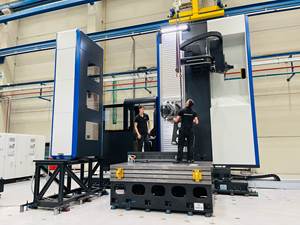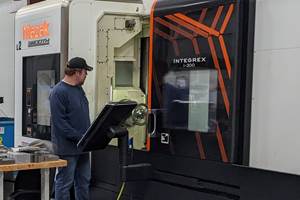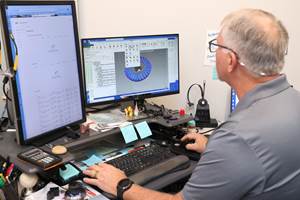Continuous Turning On Turn-Mills
A new CAM feature continuously manages B-axis head rotation to allow turn-mills to completely turn inner and outer workpiece profiles using a single tool.
Share






A clear attraction to the turn-mill platform is the possibility to completely machine workpieces in a single setup. Advancements in CAM software now allow turn-mill machines equipped with a B-axis milling head to perform finish turning of inner and outer workpiece profiles using a single cutting tool. This new lathe finishing cycle can cut continuously along inner and outer profiles in one step with just one tool, eliminating the need to use a series of turning tools with different geometries.
The B-axis contouring cycle was developed by DP Technology (Camarillo, California) and is available in the companyтАЩs Esprit 2008 CAM package. The cycle takes an efficient approach by continuously rotating the B-axis as the cutting tool follows the contour, allowing the tool to reach areas that would otherwise be inaccessible due to the toolтАЩs geometry. Using this new machining cycle reduces the number of cutting tools required, the number of tool changes and programming time while delivering a smooth, step-less surface finish. Ultimately, the possible results are saved time and money for machine shops.
Following The Contour
In June 2007, a successful B-axis contouring test cut was performed at Mori SeikiтАЩs technical center in Los Angeles, California on an NT3150 turn-mill machine. The coordinates in the NC code were output for the tool nose center using the rotate tool center point (RTCP) function of the machineтАЩs Fanuc control. The RTCP function, which must be used for the contouring cycle, makes the tool rotate about its control point rather than rotating about the B-axis pivot point.
The B-axis contouring cycle is based on EspritтАЩs SolidTurn contouring cycle. The major difference is the B-axis technology offers full control over the choice of B-axis rotation strategies and allowable B-axis angle limits.
Users can adopt two strategies to manage tool orientation throughout the turning operation. The first is to maintain a constant lead angle between the tool and the workpiece surface. Thus, the tool maintains the initial lead angle in relation to the profile being cut. This initial lead angle is a function of the original tool orientation in the B-axis head and the orientation of the first element in the profile. As the slope of the profile changes, the B-axis head tilts the tool accordingly to maintain the same lead angle relative to the workpiece surface. The total tilt of the tool is limited by a user-defined range of lead angles in addition to the softwareтАЩs automatic part/tool collision detection capability. This strategy produces the best cutting conditions by keeping the optimal angle between the tool and the surface being cut. It does, however, require almost constant movement in the B axis, which can generate over-travel motion.
The second B-axis rotation strategy is to minimize tool rotation by tilting the tool only when necessary. This strategy maintains the initial tool orientation until the tool reaches a surface that cannot be cut with the tool is in its current orientation. Only then does the tool tilt as much as necessary to cut the surface within the user-defined B-axis angle limits. This strategy, used in the test cut mentioned previously, limits the rotation of the B-axis to areas that cannot be cut at a traditional tool angle.
Both strategies are easily verified and users can display tool-axis vectors on screen to determine the best strategy for a given part geometry. The user has full control over the range of B-axis rotation during the entire cut. One way to limit the angle of the tool is to limit total allowable B-axis rotation by applying user-defined minimum and maximum B-axis angles. Alternately, for even tighter control, user-defined minimum and maximum lead angles define the allowable range of the local lead angle of the tool.
Collision Prevention
Built-in collision detection prevents a collision between the part and the tool when the tool path is calculated. Instead of relying solely on the defined tool geometry, collision detection uses a silhouette of the tool that can be modified by the user. The shape of the tool silhouette depends on the actual tool geometry and user-defined clearance values for the front and back of the tool. Extra clearance can be added around the tool to avoid the possibility of the tool gouging the material as it cuts profiles that have a similar angle to the front or back of the tool.
Programmers no longer need to create several programs using traditional methods. Instead, a single B-axis contouring operation will finish an entire profile without stopping for tool changes. Eliminating tool changes saves precious seconds in the overall cycle time and also eliminates the possibility of witness marks where one tool finishes and another begins.
About the author:╠¤Ann Mazakas is manager of technical communications at DP Technology.
Related Content
CNC Milling Tips & Tricks: 7 Articles For You to Mill Through
Dive into popular milling articles from Modern Machine Shop, Moldmaking Technology, and Production Machining to discover tips, tricks, and innovations that will make your chips fly—and your competition sweat.
Read MoreControlling Extreme Cutting Conditions in Large-Part Machining
Newly patented technologies for controlling chatter and vibration during milling, turning and boring operations promise to drastically reduce production time and increase machining performance.
Read More5 Tips for Running a Profitable Aerospace Shop
Aerospace machining is a demanding and competitive sector of manufacturing, but this shop demonstrates five ways to find aerospace success.
Read MoreTTI Brings Specialty Gear Production In-House with Multiaxis Machining
By investing in a 3+2-axis machine and utilizing simulation software for diagnostic checks, Techtronic Industries turned a four- to ten-week lead time into a one- to two-week lead time.
Read MoreRead Next
Machine Shop MBA
Making Chips and Modern Machine Shop are teaming up for a new podcast series called Machine Shop MBA—designed to help manufacturers measure their success against the industry’s best. Through the lens of the Top Shops benchmarking program, the series explores the KPIs that set high-performing shops apart, from machine utilization and first-pass yield to employee engagement and revenue per employee.
Read MoreAMRs Are Moving Into Manufacturing: 4 Considerations for Implementation
AMRs can provide a flexible, easy-to-use automation platform so long as manufacturers choose a suitable task and prepare their facilities.
Read More




















